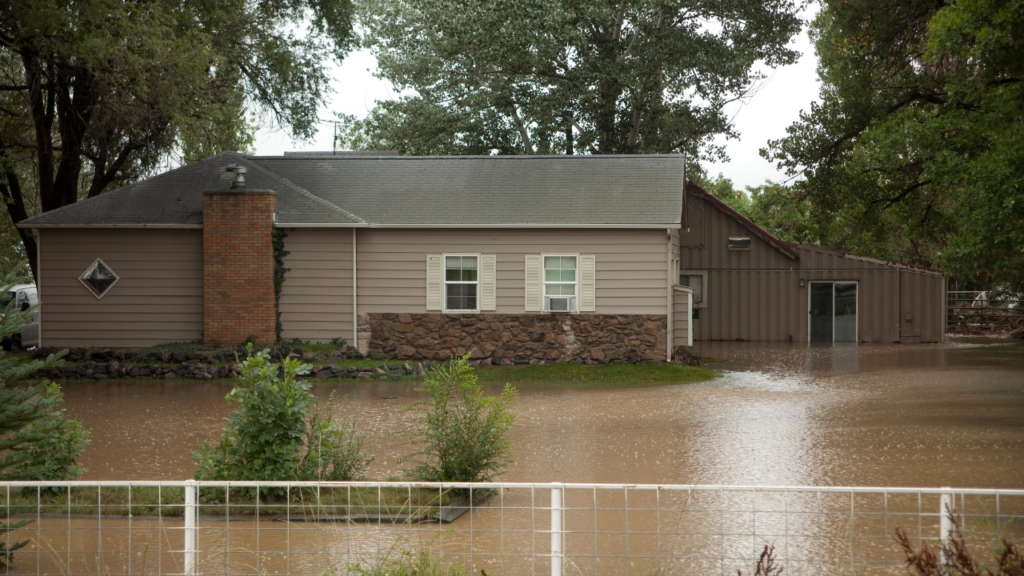
Floods can develop slowly and other times a flood can develop in minutes without visible rain signs, called flash floods. Flooding can occur from storms that produce heavy rainfall in a short amount of time, prolonged rain over several days, or when debris builds up causing a river or stream to overflow. You may have time to prepare your home for a flood, or you may need to quickly evacuate. Here are steps you can take before a flood to minimize loss of food, loss of kitchen equipment, and ensure you and your family have access to safe food.
Pack an Emergency Supply Bag
Pack an emergency supply bag in advance. You may have little time get to higher ground or evacuate. Placing these supplies in a backpack or to-go bag is recommended, including:
- A three day (72-hour) supply of non-perishable food and water per person, including infant formula. Don’t forget pet food!
- Battery-powered radio with extra batteries
- Flashlights, candles, matches, and kerosene lamp
- Phones and chargers
- Emergency cooking equipment like a camp stove with fuel, a manual can opener
- Paper plates/paper towels/cups/utensils
- A first aid kit and prescription medications
Know How to Shut off Utilities
In the event of a flood, local officials usually recommend shutting off the water, gas, and electricity at the main power switch. Practice locating and shutting off utilities in the home.
Move Items and Appliances
If you have time, moving items out of danger of flood waters can help reduce loss of food, equipment and expensive appliances.
- Move canned foods, non-perishable foods, stored drinking water and emergency supplies from lower kitchen cabinets and basement to a higher area in your home.
- Similarly, move cleaning supplies and hazardous materials (i.e. paint, oil, etc.) to a higher level to prevent contacting water. Do not store above food.
- Move appliances to a higher area. If appliances (freezers and refrigerators) can’t be moved, place them atop cement blocks or, wrap them in polyethylene film, tying the film in place with cord or rope.
72 hour Emergency Food Supply
Trying to keep perishable foods safe during a flood is difficult. Building an emergency supply of non-perishable foods can help supply safe food to you and your family. Recommended foods for your three day food supply:
- Fish, canned – 18 months
- Canned potatoes – 30 months
- Dehydrated potatoes – 30 months
- Canned fruits and vegetables – 24 months
- Canned fruit juices – 24 months
- Canned fruit juice – 24 months
- Canned vegetable juice – 12 months
- Pickles – 12 months
- Jams and jellies – 18 months
- Rice, dried – 24 months
- Cornmeal – 12 months
- Pasta, dried – 24 months
- Cold breakfast cereal – 12 months
- Prepared flour mixes – 8 months
- Packaged dry beans, eas, and lentis – 12 months
- Canned evaporated milk – 12 months
- Dry milk produces – 24 months
- Water – 1 gallon per person per day for drinking, cooking, and personal hygiene
Check product dates and rotate supplies before expiration.
Recommended Food Storage Containers
- Store food in food-grade containers.
- Package dried foods in airtight, moisture-proof, insect-proof containers such as glass jars or plastic freezer boxes or bags.
- Metal cans with tight-fitting lids can be used if the dried food is first placed in a plastic bag.
- Package dried foods in small amounts; once the package is open, the food can absorb moisture from the air and quality will deteriorate.
Prepare for Power Failure
Loss of power to your home means loss of electricity for refrigerators and freezers. To minimize throwing out a lot of food, create a plan for preventing food from becoming unsafe. Food that contacts flood water is unsafe. Move foods away from flood water. Depending on amount of time you have, here are some tips to keep food cold during loss of power:
- Before power shut off, turn your refrigerator and freezer to the coldest setting. Freeze refrigerated items that you may not need immediately.
- Keep freezer full. Fill empty spaces with gel packs, bags of ice, or frozen water jugs. Grouping foods together helps food stay colder for longer.
- Keep a thermometer in both refrigerator and freezer to ensure food is 40°F or below.
- Have a large, insulated cooler and frozen gel packs available. Perishable foods will stay safe in refrigerator for only 4 hours. If power is out for longer, transfer food to a cooler and fill with ice and gel packs. Add more ice to the cooler as it melts.
- Locate where dry ice can be purchased. A 50 lb. block of dry ice can keep food in a full 18-cubic-foot freezer safe for 2 days. Do not touch dry ice with bare hands or place in direct contact with food.


